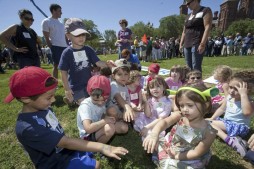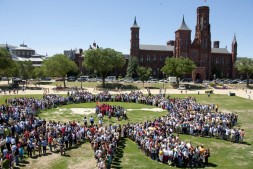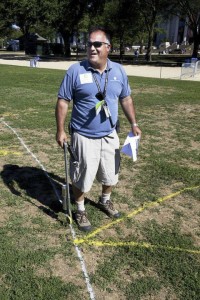It’s just geometry!
It started off as joke during a preliminary brainstorming discussion about the upcoming 2010 Smithsonian Staff Picnic. What if all the staff, volunteers and interns—in an organization with about 6,000 staff alone—gathered together for a single group photo? And what if they were all arranged in the shape of a giant SI sunburst? Ha! What a riot.

Kindergarten students from the Smithsonian Early Enrichment Center show off their SI tattoos as they wait to take their places. (Photo by Eric Long)
It was obviously a wildly impractical idea. How big would this sunburst have to be? How could so many people be organized into a recognizable shape? Where would everyone stand? How would the photographer capture such a huge photo? And how many staff would actually participate? And yet, says Charlie Weber, one of the co-chairs of the staff picnic planning committee (and the originator of the crazy idea), “The group kept coming back to it—we realized it could work.” Nikki Krakora, the event’s other co-chair adds, “And once we realized it had never been done, we knew we had to find a way to do it.”
Once the group had committed to their crazy idea, it took on a life of its own. “It seems like everywhere we went in the Institution, we found people who could make it bigger and better,” says Charlie, an A/V specialist with the Center for Folklife and Cultural Heritage. “It’s like the [Folklife] Festival itself: You set it in motion and there’s no stopping it.”
Before long, the photo was going to be shot from multiple cameras and vantage points! In 3D! From the Castle tower! From bucket cranes! With 50 megapixel cameras! And filmed by Smithsonian Networks! “We didn’t come across a single person who said ‘no’ during this process,” says Nikki. “Not a single one.”
The picnic committee quickly realized they needed to tap someone with the know-how to turn their ambitious idea into reality. As the technical director for CFCH, Robert Schneider was just the man for the job. Every year under his direction, a half-mile stretch of the National Mall is transformed into the largest cultural celebration in Washington, D.C. Even so, Charlie was skeptical that the precise 16-pointed Smithsonian sunburst logo—replete with both simple straight rays and complex wavy rays emanating from it—could be accurately transformed into a chalk outline on the Mall. Robert’s response? Relax. “It’s just geometry, Charlie.”
Just geometry, indeed. Robert insists the process wasn’t all that difficult. Fundamentally, it was “the same techniques the ancient Mesopotamians or Egyptians used to lay out large structural foundations,” he says. “The primary tool was a long length of rope, or line. We used that line incrementally to make a large compass out of it, then struck arcs onto the perimeter coming from the primary circle.”
Robert readily admits, though, that the eight wavy rays were by far the most difficult element to create; each is composed of eight arcs, or segments of a circle, and the Folklife Festival team realized that accurately reproducing each of the arcs would have been prohibitively labor intensive. Instead, they devised a way to get the same effect using a technique Robert calls “hog troughing” in which they created a “linear template with one central spine. There were points coming off to the left and to the right. Connect the points and it makes the curve.”
See? It’s just geometry.

The rays have been filled and staff from Smithsonian Institution Libraries take pride of place in the center. (Photo by Eric Long)
With a touch of pride, Robert notes that the chalked outline on the Mall wasn’t just a rough approximation of the officially sanctioned logo—it was an exact, scaled-up reproduction. All the measurements “were based on the acceptable design.” And so it was that the final chalked outline was not just 152 feet across, but 152 feet and four inches across. “It’s the same ratios. Just bigger.”
Of course, before the final size of the sunburst could be locked down, the picnic committee had to figure out how many people would be filling it. Overestimate the number of participants and the sunburst would end up vague and sparsely populated; underestimate and the extra people would be squeezing out of the lines, ruining the carefully delineated shape. Fortuitously, Nikki is really good at accurately estimating attendance at an upcoming event; as the director of the Institution’s office of Special Events and Protocol, it comes with the territory.
The planning committee eventually settled on an expected attendance of 3,500 staff members with a group density of one person for every three square feet, a concert industry standard for standing-room audiences. Of course, contingency plans had to be made in case the actual number of participants varied from the projections. If too few people showed up, just an outline of the sunburst would be formed with the center left empty; if too many arrived, they would be directed to form a circle around the edge of the rays, creating the sky that encircles the sunburst.
The planning committee agreed well in advance that the 16 rays were the most critical part of the photo and needed to be filled in first. If they weren’t clearly defined, the carefully laid out sunburst would end up as little more than an amorphous blob. The density calculations called for 126 people to be assigned to each of the broader wavy rays, while 73 people filled each of the narrower straight rays. It was the job of 26 volunteer ‘photo wranglers’ to gather together these groups and arrange them in the rays before the center was filled in.
At one point, Nikki explains, the planning committee had considered purchasing yellow shirts or hats for everyone so that the sunburst would be appropriately colored. They finally decided against it, “Not just because of budget constraints,” she says, “but also to better represent who we are—suits, animal keepers, security guards and more.” The planning committee also considered grouping various units together as they entered the photo, but rejected that idea. “We didn’t want there to be divisions,” says Nikki. “It was a logo without borders.”
Acting as the conductor for the project was Richard Kurin, the Undersecretary for History, Art, and Culture, who had been drafted as emcee the night before. As participants arrived to the photo shoot, they found him high above their heads in a scissor lift calling out helpful instructions (such as ‘Now boarding ray number seven’ or noting that another photo would have to be taken because someone had blinked) through a megaphone. “He kept it light and he kept it fun,” says Nikki. “He was not only the director from up there, but he was the biggest cheerleader as well.”
It was also Richard’s job to initiate countdowns for a few photos in order to synchronize the shutters of the 3D cameras being used. Because images from two cameras in two different cranes were going to be digitally combined into a three-dimensional photo in post-production, it was vital that the pictures be captured at the same time.

Eric Long (holding camera) discusses camera angles with the other photographers and project managers.
Eric Long, a photographer with the National Air and Space Museum, was drafted by the picnic committee as the chief photo coordinator, a role that required every bit as much planning as constructing the logo shape itself. How many photographers would be required to capture this first-of-its-kind opportunity? Where would the sun be at 11:00 a.m.? Could the photographers get the Castle in the background without making everyone look into the sun? “We didn’t want people squinting” with pinched faces that would make “everyone look like they hated their job,” Eric explains.
With the goal being a final photo with sufficient resolution that each face in the crowd would be identifiable, Eric knew that some specialized equipment would be required. He sent an e-mail to SI photographers across all the units asking what resources they could bring to bear on the project. “We needed high-end digital equipment. Whoever had the highest megapixel camera was going to take the center [crane].”
That camera ended up being a 50 megapixel medium-format beast with resolution significantly better than even the best consumer equipment. Combined with ‘lesser’ cameras of only 20 and 30 megapixels, the 13 traditional photographers and two 3D photographers captured several hundred photos between them. Eric alone says he shot about 250 images, mostly of staff working the event. Knowing that there was plenty of camera firepower focused on the sunburst itself, “I was looking at it more from a behind-the-scenes standpoint,” he says.
Eric laments that, busy as they were behind the lenses, none of the photographers were able to be a part of the staff photo and joked that maybe they’d just Photoshop themselves into the final product.
Even with thousands of events under her belt, Nikki admits to having been worried in the days leading up to the photo: “I was pretty sure no one was going to come. I was pretty freaked out.” Given the actual turnout—estimated at nearly 4,000 people—such worries were obviously unfounded. “I turned to Charlie and said, ‘they all came!’”
And apparently they enjoyed themselves, too. “The picnic ended at 2:00,” says Nikki. “By 2:15 I was getting e-mails asking ‘where’s the photo?’” Nikki posted some of the raw pictures to her Facebook profile that evening with links to the SI Newsdesk, and the images started making the rounds. Within days Newsdesk “got 1,100 unique page views from Facebook alone—and I don’t have 1,100 Facebook friends!” Nikki notes that within an hour of her post to to the social networking site, one of the sunburst photos had already reached its limit of 50 ‘tags’ as people identified themselves in the picture. She’s even noticed that some people have changed their profile picture to the sunburst image. “I think we really captured the spirit of the Institution,” she says.
Reflecting on the event afterwards, Charlie says that the sunburst is more than “just a logo to us, it’s a symbol of what the Smithsonian does best—our ideas and energy that we can give people.” Nikki, recalling one of her favorite moments from the event, recounts how everyone turned around to face the photographers in one of the Castle towers—everyone, including the people who had been holding the sign boards in front of the sunburst. “Here we have some of the most brilliant and educated people on the planet spelling out ‘We are the Smithsonian’—backwards.” The sign-holders quickly realized their mistake and lowered the signs, but not before just one photo was snapped for posterity.
!NAINOSHTIMS EHT ERA EW, indeed.
For something that started out as little more than a joke idea to get the creative ball rolling, the staff photo certainly turned out pretty well. At any rate, says Charlie, “It was definitely better than my first idea for a group photo. Naked scientists.”
Click link to see time-lapse video. Sunburst
Posted: 27 July 2010
- Categories:






